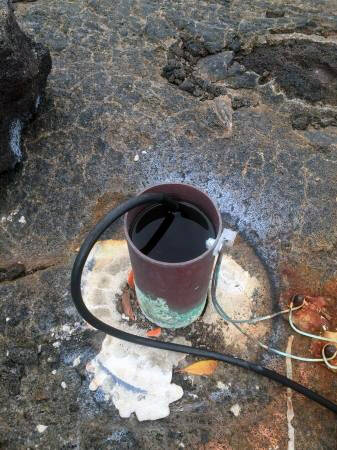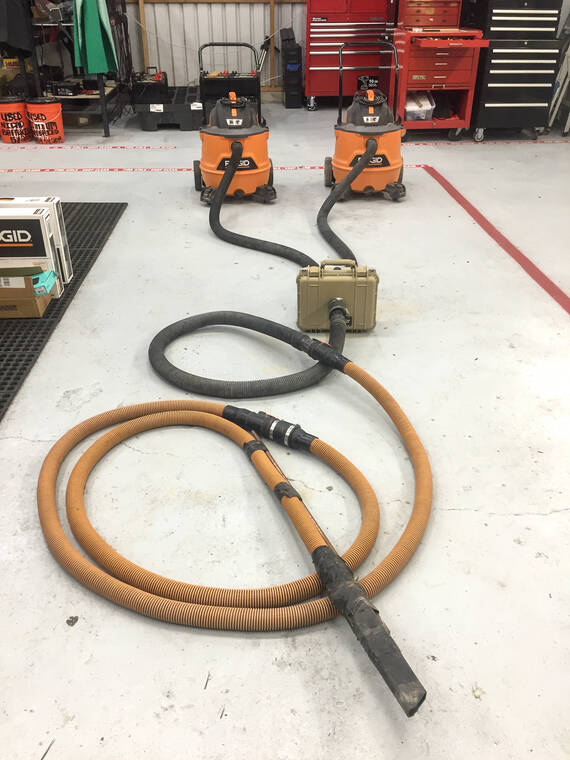Volcano Watch: STEM and suction solutions at HVO
STEM is an acronym that stands for Science, Technology, Engineering and Mathematics. In the educational system, encouraging STEM curriculum prepares students for future careers in STEM fields. In this “Volcano Watch” article, we’ll describe how aspects of STEM are applied at the USGS Hawaiian Volcano Observatory, using a specific example of field engineering work.
Staff at HVO study volcanic processes and associated hazards in Hawaii, with the emphasis and end goal of protecting life and property. The backbone of the observatory is the monitoring network, consisting of a diverse array of instruments located on the flanks of the volcanoes. These instruments relay data back to the observatory, providing information on the behavior of Hawaii’s active volcanoes.
The monitoring network is installed and maintained by the HVO field engineering team. Many hours are spent commuting to and from remote field sites. At any one site, field engineers do a variety of tasks, such as changing batteries that power the station, clearing vegetation from near the station, or changing parts that are broken or need to be upgraded. In the shop, field engineers build new stations or station modules, and engineer solutions to solve station-related issues.
One important instrument in the HVO monitoring network is the tiltmeter, which records subtle changes in how the ground tilts over time. These tilt changes give an idea of the pressure in the underlying magma reservoir.
The data output of the tiltmeter is represented on a time series plot. Scientists specializing in ground deformation at HVO interpret tilt data, paying particular attention to whether the data are trending towards inflation or deflation. The tiltmeters at Uekahuna and Sand Hill on Kilauea, for example, provide information on the Halema‘uma‘u and south caldera magma storage areas beneath Kilauea’s summit region.
HVO field engineers install tiltmeters below the ground surface, so that they can be protected from weather and other elements near the surface. The instruments are housed in a pipe casing that is filled with dry sand; the depth of the tiltmeter is site specific.
During a past storm system, accompanied with torrential rains, water had infiltrated a site specific tiltmeter casing. Nineteen feet of the casing depth was filled with wet sand and water, negatively impacting data quality.
The casing had to be cleared of the wet sand and water. The question was, how? Ordinarily, we would use a wet/dry vacuum to extract out the dry sand from this casing, for example if the tiltmeter needed to be replaced. Unfortunately, the negative pressure of one wet/dry shop vac was inadequate for wet sand extraction at this depth because wet sand has a higher density (mass/volume) than dry sand.
An increase in negative pressure would be required to remove the wet sand. This was accomplished by integrating two vacuums into one inlet hose. To ensure an airtight environment that would couple the two vacuums, a plastic enclosure with a rubber seal was designed. This combined all the negative pressure being created by the two vacuums, providing increased suction action to extract the wet sand in one hose. One vacuum source provided suction for half of the volume of the hose, while the other vacuum source provided suction for the other half of the volume of the hose. In essence, the suction power was doubled within one hose, allowing the dense and wet sand to be pulled into the hose.
With over 200 instruments across the Island of Hawaii, HVO field engineers are adept at adaptively responding to the various situations that can occur at these remote monitoring stations. This suction solution is just one example of how the HVO field engineering team uses aspects of STEM to problem solve.
Volcano activity updates
Kilauea is not erupting. Its USGS Volcano Alert level is ADVISORY.
Average earthquake counts below Kilauea’s summit over the past week were below 30 detected events on most days. This remains well below the amount detected during the January–February intrusion or prior to recent summit eruptions. Tiltmeters near Sand Hill and Uekahuna bluff continued to record modest inflationary trends over the past week. No unusual activity has been noted along the rift zones.
Mauna Loa is not erupting. Its USGS Volcano Alert Level is at NORMAL.
Webcams show no signs of activity on Mauna Loa. Summit seismicity has remained at low levels over the past month. Ground deformation indicates continuing slow inflation as magma replenishes the reservoir system following the 2022 eruption. SO2 emission rates are at background levels.
Two earthquakes were reported felt in the Hawaiian Islands during the past week: a M2.9 earthquake 9 km (5 mi) NE of Pahala at 33 km (20 mi) depth on March 31 at 7:58 p.m. HST and a M3.2 earthquake 93 km (57 mi) SW of Lanai City at 10 km (6 mi) depth on March 28 at 9:56 a.m. HST.
HVO continues to closely monitor Kilauea and Mauna Loa.
Please visit HVO’s website for past Volcano Watch articles, Kilauea and Mauna Loa updates, volcano photos, maps, recent earthquake information, and more. Email questions to askHVO@usgs.gov.



